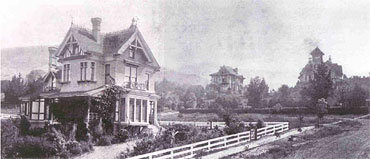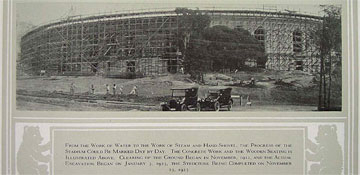UC Berkeley Press Release
Q&A about the oak woodland west of California Memorial Stadium
Q. What was the original character of the hillside?
A. We have no clear photographs of that slope in particular from before early residential or institutional development. We do know that the stadium site was a ravine filled with large, old, riparian trees — probably bays, buckeyes, etc. — and some oaks. Descriptions of the area before development and during the stadium construction note that there were many large trees in the creek ravine itself. However, the current slope below the stadium, which lay over a ridge from the creek ravine, was probably less densely wooded, with a scattering of large live oaks. At least one of those oaks seems to have survived.
Q. What was the character of the hillside in historic times, before the stadium was built?
 This image circa 1885 is taken from Bancroft Way, looking east towards the stadium site. The house in the left foreground is on the current site of Simon Hall at Bancroft and Piedmont. The two houses in the background are the "Palmer Houses" that stood on top of the ridge west of the stadium site; the area below them, down to the dark hedge along Piedmont, is the slope where the current oak grove stands. No large, old, oaks are evident in this photo, although some of the smaller mounded trees may be oaks. (Berkeley Architectural Heritage Association, Clinton Day collection) |
Late 19th century drawings and photos of the houses show the gardens around and below them planted in a typical exuberant Victorian style, with a variety of exotic trees and shrubbery. Most of these are younglooking specimens (a few decades or less old), and few can be clearly distinguished as having the growth form of live oaks.
What happened to the hillside landscape when the stadium was built?
At least five houses / structures were moved downhill and across Piedmont Avenue to a piece of land purchased by the university in the vicinity of today's Haas Business School complex (all those relocated houses have since been demolished). The entire site of the stadium oval itself was cleared of vegetation; the trees were cut down, then the large stumps were blown out of the ground, and debris removed.
West of the site of the stadium oval, least part of the old garden landscape on the slope between the stadium structure and Piedmont appears to have been cleared, but some trees remained.
Q. What remained?
A. The stadium historic landscape report identified — on the basis of historic photos — up to seven mature live oaks on the hillside that appeared to have survived stadium construction (1929 composite plan, page II-30 Memorial Stadium Historic Landscape Report, March 2006).
 This image taken during stadium construction shows, at right-center, above the second car, Tree T150, a live oak, that remains today northwest of the stadium, as well as cleared space around it. The taller tree behind and to the left of the oak may have been a eucalyptus; it has since been removed. (1924 Blue and Gold yearbook) |
It's also likely some exotic (non-native) trees from the late 19th century Victorian-era gardens — cedars, a California pepper, perhaps an olive — survived the stadium construction on the hillside.
All of the other existing trees on the hillside, including most of the current "oak woodland" were apparently planted after the stadium construction. There was a landscape plan prepared by the firm MacRorie & McLaren, and most of the trees around the stadium appear to have been planted in accord with that design.
Pathways and plantings in the MacRorie & McLaren plan were apparently planned and adjusted to accommodate some of the older live oaks remaining on the site, outside of the stadium bowl. As noted above, four of those pre-stadium oaks appear to remain on the slopes above Piedmont.
Q. How do we know this about the hillside after stadium construction?
 Stadium vicinity, 1928. This is approximately five years after the stadium was completed. Note the dark clusters of larger trees that predate the stadium, as well as the areas of smaller dots that indicate post-stadium tree and shrub plantings. These post-stadium tree plantings appear west and northwest of the stadium (top of photo) on the slope above Piedmont, above the stadium at the mouth of Strawberry Canyon, and on the lower slopes of Charter Hill. Note that west of the stadium they appear to infill some fairly large gaps between the scattered older, mature, trees. |
In some places there are clearly large mature trees or small clusters of trees that remain from the pre-stadium era; they are too large in the photos to have grown up in the few years since the stadium was built.
In other areas—such as the lower slope of Charter ("Tightwad") Hill, there are clearly new plantings of small saplings arranged at even intervals.
The hillside below the stadium exhibits this character. There are some clumps of older trees, but also several open areas and patches of uniformly sized small saplings.
Q. Is the hillside "old growth oak woodland"?
A. No. It has possibly four oaks that pre-date stadium construction. Three are relatively near each other, and the fourth stands alone and is significantly older than the others (Tree T150, 60 inches in diameter, and probably hundreds of years old).
The rest of the current "oak woodland" is a planting that dates from historic times — the first half of the 1920s (about 50 years after the University of California moved to the Berkeley campus site). The historic landscape report called this a "significant stand of mature oaks" (page IV-5), but it is not an "old growth" woodland which implies an entire grove that survives from pre-settlement times. There are however, as noted above, some individual trees that probably pre-date the university.
Old growth forest or woodland is typically defined as being 180-220 years old, with minimal human disturbance. "Many botanists specifically define old growth in terms of meeting several criteria, under which system forests with sufficient age and minimal disturbance are considered old growth. Typical characteristics of old-growth forest include presence of older trees, minimal signs of human disturbance, mixed-age stands, presence of canopy openings due to tree falls, pit-and-mound topography, down wood in various stages of decay, standing snags (dead trees), multi-layered canopies, intact soils, a healthy fungal ecosystem, and presence of indicator species." (Source: http://en.wikipedia.org/wiki/Old_growth_forest)
By these criteria the woodland west of the stadium is not "old growth". It has one indisputably old live oak, three others that appear to predate 1923, and dozens of specimens planted by humans in the 1920s and later, along with an intermingling of non-native trees. The oak grove has been significantly disturbed and managed by human intervention, particularly in the 1860s-1923 period when it was part of a residential garden, and in the 1920s when much of the vegetation was removed and replanted. The area might best be described as a mixed woodland that has been periodically cleared, reshaped, and managed by human intervention.
Q. How do these oaks compare to other oaks on the campus?
A. Most of the original oak trees — those predating the university — on the campus grounds have long since died or been cut down.
Today, there are a number of specimen oaks on the main campus and small oak groves that are similar in age or older than the 1920s grove planted below the stadium. None compare in age or size to oaks that predated the university and appear in early photos of the campus; these images show enormous trees with trunks several feet in diameter.
However, tree T150 adjacent to the stadium is clearly one of the oldest oaks on the campus, and may well be the oldest on the lower campus. There may be older trees in the less-developed parts of Strawberry Canyon, but probably not on the central campus itself.

